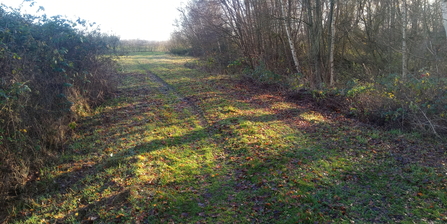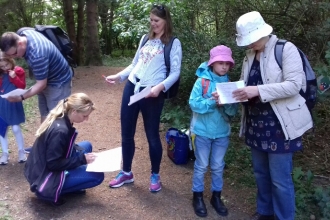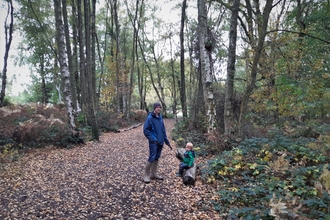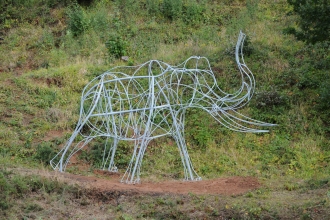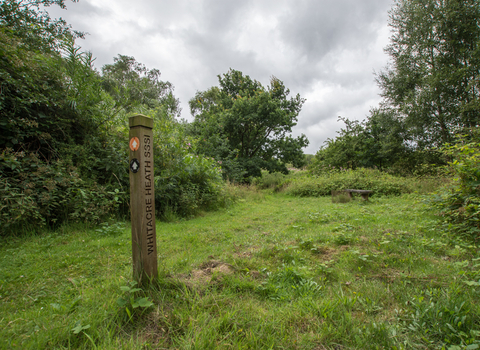
Whitacre Heath walking trail
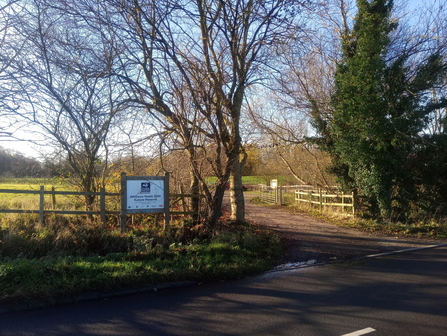
Whitacre heath has a medium sized car park for members (padlock access code on the back of your membership card). There is space between the road and gate to pull into while opening and closing the gate. There is also a pedestrian gate for if you have started your walk from further afield. Find out more about the reserve here or read on for details of waymarked trails with activities for the whole family to enjoy…
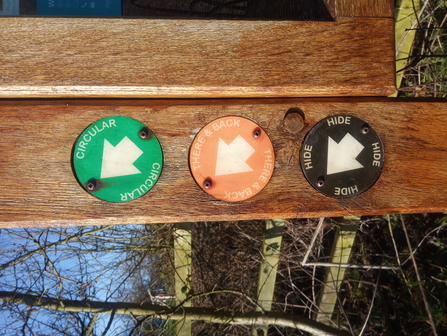
In the car park you are welcomed by an information board which includes a map that you could take a photo of to help you on your way. At Whitacre Heath there are two waymarked trails as well as some other routes to enjoy, or combine them to get the full experience of Whitacre Heath. Here is an example of each type of way marker you will find:
- Green: circular trail (allow 1-2 hours)
- Red: there and back to a view point over the River Pool (allow 30 minutes- 1 hour)
- Black: directions to hides and viewpoints from the circular trail:
- To the Main Pool view point with hide
- To the scrape view point
- To the woodland hide
- To the grassland view point with hide (this can also be access by walking along the raised wide grassy path from the car park)
There are a total of 8 brass rubbing discs to find on way marker posts (don’t forget to look on the back!) around the reserve so remember your crayons and paper!

Follow these instructions to do both trails and visit all the viewpoints.
Click of the arrows for full details and activities.
Head through the metal gate to enter the reserve, following the raised wide grassy track to start your walk.
Red: there and back
If you wish to do the there and back trail follow these instructions:
Start of there and back trail
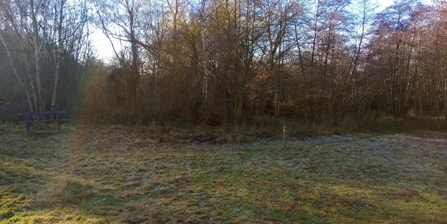
Turn right off of the wide path at the first bench onto a narrower path with a way marker.
Activity: Stop to look at the wildflowers.
Try smelling at least 4 different types of flowers around you. What do they smell like and do they remind you of anything?
In the past, Whitacre Heath has not been renowned for its floral species, but this is changing and the site is now noted for its population of striking species like the Southern-marsh orchid (Dactylorhiza praetermissa) and Blue fleabane (Erigeron acris), which can both seen flowering in this area in early to mid-summer. Try exploring the area around you and look to see how many different types of plants you can see. Beautiful species such as Red campion (Silene dioica) with its dark red to pink flowers can be seen here in summer, along with a sea of grasses including Tufted hair-grass (Deschampsia cespitosa) and Yorkshire-fog (Holcus lanatus). Throughout the year some of the plants around you provide a wonderful display of flowers. Teasels are especially prominent during the summer and the very thorny thistles often grow as tall as a person between July and August. These and other plants are a valuable source of pollen for bees and seeds for birds later in the year, and can even still be seen during the winter.
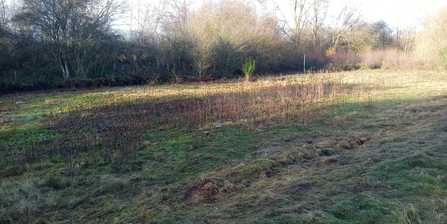

Ragwort is the food plant for the cinnabar moth caterpillar often seen in early summer at Whitacre Heath.
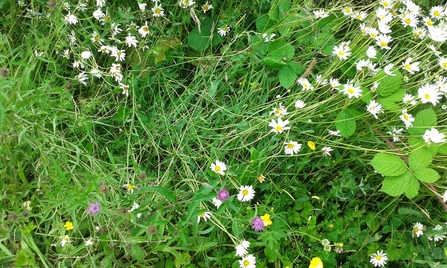
Now carry on along the narrow path looking out for way markers and brass rubbing discs along the way. Stop when you get to the next bench.
Activity: Trees
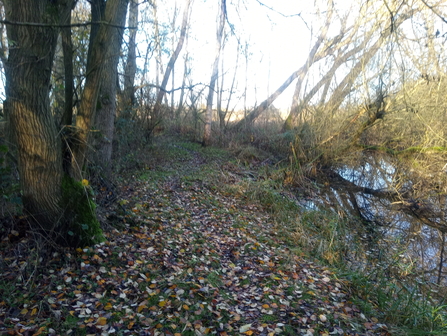
You have just walked the path through some of the damp woodland that is typical here at Whitacre Heath. The series of pools and ponds that you passed to get here are home to many amphibians and reptiles that thrive in these moist conditions. Did you find the common toad?
This area is also great for bugs. An invertebrate survey in 2000 identified 1,145 species and included substantially large numbers of nationally rare species.
Take a seat on the oak bench ahead and look out for some of the orchids that can be found nearby during summer. In this open area you have a lovely view of a selection of native trees including willows, silver birch and oaks. Download and print this spotter sheet to help you identify the trees using their leaves.
Printable leaf spotter sheet
Keep walking to reach the view point...
Activity: Watch and listen
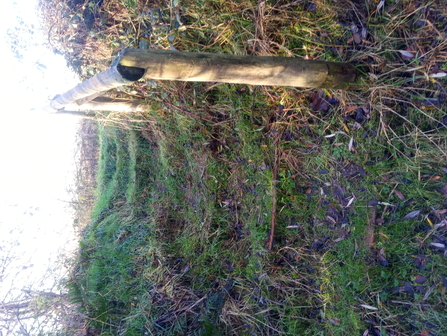
These steps take you up onto higher ground for stunning panoramic views over the River Pool.
What can you see and hear?
Take a look at this film clip of the view in winter. How is it different to your visit?
Now retrace your steps back to the raised grassy path, turn left onto it to return to the car park or turn right to continue exploring…
Green: circular trail
From the raised wide grassy path, a few meters after the bench with carvings, turn right and down to follow a narrower path. The fly agaric way marker on your right marks the start of the circular trail.
Start of circular trail
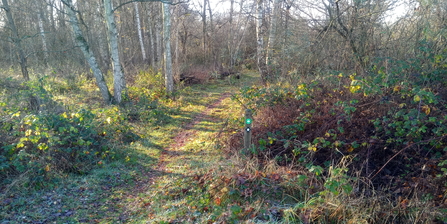
Activity: Fungi
The wet nature of the woodland on the reserve provides ideal habitat for a variety of interesting fungi, mosses and liverworts. Many of the fungi that can be found here can be difficult to identify, but there are some very recognisable species to look out for during autumn months, like fly agaric (Amanita muscaria), with its distinctive red cap with white spots.
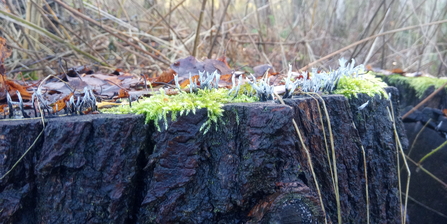
This is candlesnuff fungi, best seen in autumn. Give the end a flick to see the spores waft like smoke.
Follow the path, keeping your eyes and ears open!
Activity: Tracks

Look into loose/bare soil and mud to see if you can see any signs of other passing visitors.
These prints belong to a muntjac.
Stop when you get to the next way marker.
Activity: Stick art
Try collecting sticks that can be found in this area to make the shape of a fish on the ground next to the way-marker post for other visitors to enjoy looking at. When you have done this, try making the shape of a hedgehog instead.
Himalayan Balsam
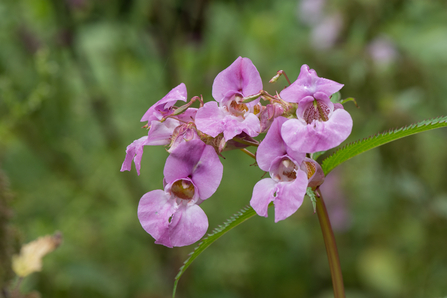
If you are visiting from spring - autumn, there is a good chance that you will see areas of the species Himalayan balsam (Impatiens glandulifera) around Whitacre Heath, either growing in high stands or placed in piles on the ground. Himalayan balsam is an invasive species and originates from India and Pakistan. It is considered a controversial species as it is out-competes other native plants for nutrients and sunlight, leaving bare ground when it dies out in winter. This species puts on a prominent display of pink flowers during late-summer at Whitacre Heath. However each plant contains thousands of seeds and when they burst, they are projected up to 7m (23ft), so spreading the species over large areas of land each year. In 2019 our colleagues at the Tame Valley Wetlands partnership working with CABI scientists, introduced a biocontrol to help manage the Himalayan balsam. The biocontrol is a ‘species specific’ rust fungus so it will only affect Himalayan balsam that has been given Government approval for release after ten years of research and consultation. A control area was designated for the fungus application.
Detour to the Main Pool hide
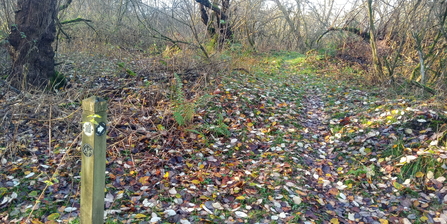
Detour to Main Pool Hide
It is certainly worth taking the right hand path at the Himalayan balsam brass rubbing disc to the Main Pool hide.
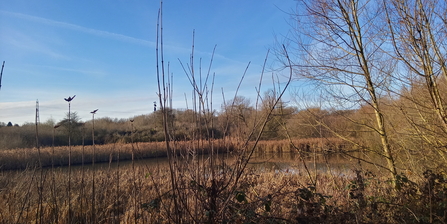
View of the Main Pool
Whitacre Heath Nature Reserve is a 90.5ha site and was designated a Site of Special Scientific Interest (SSSI) in 1989, primarily on the basis of its breeding winter birds.
How many different birds can you spot?
Print off these bird spotter sheets to help you identify them, for any others take photos or draw them so that you can find out what they are when you get home using the Wildlife Trusts species A-Z on our website or use the children’s Wildlife Watch website for a child friendly version.
Duck spotter sheets
River Bird spotter sheet
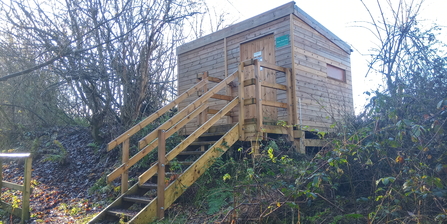
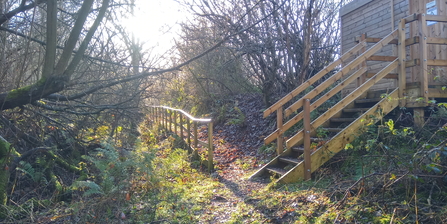
Continue to get Back to the main path or retrace
If you continue to follow this path on the right of the barrier you will be able to re-join the circular trail at the next activity point or you can retrace your steps to the circular trail.
Activity: Time for a rest
This bench is very well located for a rest. In spring it is surrounded by bluebells and then a carpet of forget me nots follow. If you are visiting in summer, have a look for the incredibly colourful damselflies and dragonflies that can be seen from here, like the broad-bodied chaser (Libellula depressa) that is illustrated on the way marker post nearby. (If you have taken the detour to the Main Pool you re-join the circular trail near here.)
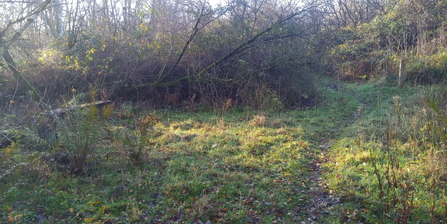
Activity: Mini rafts
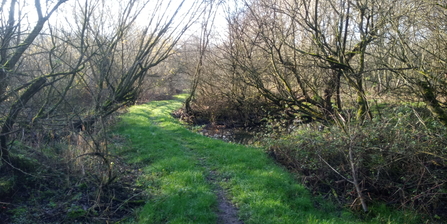
The snaking path beyond twists its way through a series of more ponds, pools and increasingly wetter woodland.
During times particularly heavy rain, the River Tame floods its banks and can leave the areas around you under water, creating a very unique set of conditions for wildlife to flourish in.
Can you make a raft out of grasses and float it in one of the ponds around you? Try making two grass rafts and racing them!
Willow trees can be seen in all directions during this section of the trail. Here the trees appear to drape over each other, creating a natural tunnel that creates a special atmosphere unique to this nature reserve.
Detour to the Scrape view point
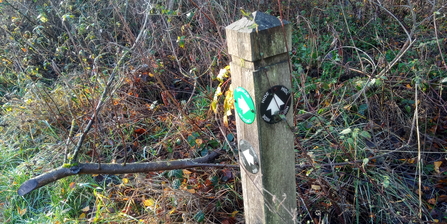
At the next way marker you can continue to the left to stay on the circular trail or take the slightly right path to a view point overlooking the Scrape, which is a landscaped pool developed to maintain water depth and reedbed cover for wetland species, including overwintering birds.
Whitacre Heath is particularly noted for its population of birds, with over 140 species recorded since the early 1980s. In summer warblers are abundant with Reed warbler, Sedge warbler and Lesser whitethroat often present, along with charming Little grebes and Tufted ducks that breed here regularly. Use your bird spotter sheets so you know what you are looking for.
Kingfishers can be seen from this hide, often glimpsed as a bright blue and orange flash. They fly rapidly, low over water and hunt fish from riverside perches, occasionally hovering above the water’s surface. Just behind the treeline is the River Tame which meanders southward along the reserve, then westward towards the city of Birmingham.
Try closing your eyes tightly and sitting silently for 1 minute. Now tell each other what you heard during that time. Did you hear anything nearby? What animals could you hear around you? Possibly non-natural sounds too – which do you prefer?
Retrace your steps back to the circular trail.

View over The Scrape
Keep going you are over half way round!
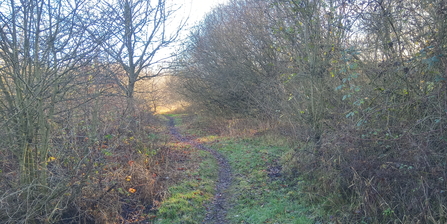
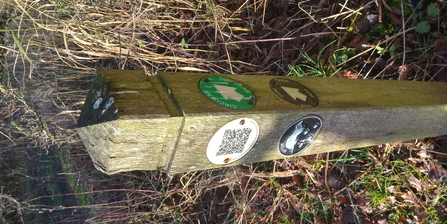
Activity: Look for beetles

You will soon arrive at a raised boardwalk that navigates its way back through the wet woodland, giving you a very interesting raised perspective through the dense vegetation. Have a close look for insects whilst walking over the boardwalk. Large numbers of beetles live here and particularly thrive around areas of dead wood. Did you see any?
The boggy conditions around you are a result of poorly drained soils and seasonal river flooding. Birch, alder and willow trees can all be admired along this stretch of the trail.
Whitacre Heath lies on alluvial/glacial gravels in the flood plain of the River Tame and is one of a chain of water bodies created by gravel extraction along the valley that are now very important for their bird life.
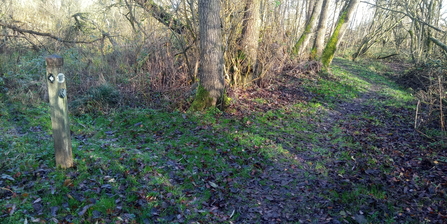
Detour to the Woodland Hide
When you reach the great spotted woodpecker brass rubbing disc you can turn left to the Woodland Hide or go straight on to continue along the circular trail. Woodland Hide that offers a great place to relax and soak up the tranquil atmosphere under the woodland canopy. This hide is perfectly located to see and hear a variety of woodland bird species including Woodpeckers and Jays. Download the spotter sheet below to help you identify them.
Close your eyes: Can you hear stones clapping together? That is the warning call of a blackcap!
Male and Female Bird spotter sheet
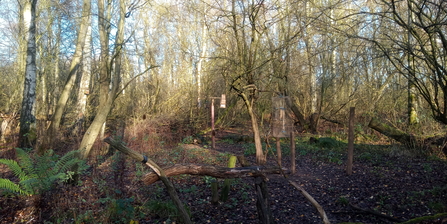
View from Woodland Hide WH
The Woodland Hide was presented by the Atherstone Natural History Society to commemorate their 20th anniversary in 1992. Visit www.athnhs.webs.com/ for more information about the Atherstone Natural History Society.
Retrace your steps back to the circular trail.
Activity: Hide and Seek
Play a game of hide and seek with your friends. Try playing the game using the way-marker posts as the boundaries.
Whitacre Heath was used for sand and gravel extraction in the 1960s. Following this extraction, the site levels were restored with waste materials and pulverised ash, tyres and domestic waste and then restored for agricultural use in later years. There are still signs of this former industrial past that are hidden around the reserve, see if you can find any while you play…
Home straight!
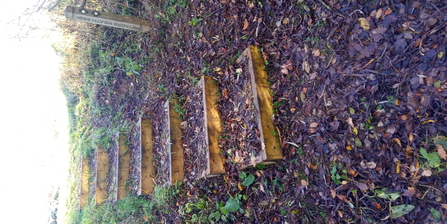
These steps take you back up onto the wide raised grassy path where you can turn left to complete the circular trail and head back to the car park or you can turn right for a walk to the grassland view point and hide.
To the grassland view point and hide.
Walk along the raised wide grassy path until to come to a wooden gate, proceed through.
Grassland path
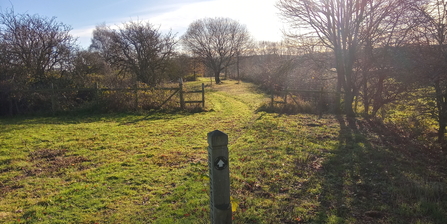
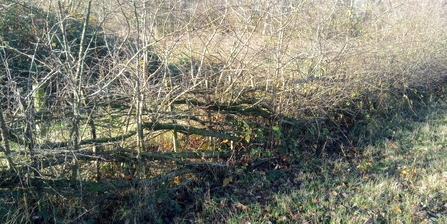
In 2017, the Tame Valley Wetlands partnership engaged contractors to restore 170 meters of hedgerow which can be seen on your right as you walk along to the hide.
Activity: Watch for butterflies
Depending on the time of your visit, this sunny area of the reserve is great for butterflies. on the way you may be able to see some of the 25 species of butterfly that have been sighted on the reserve, including locally important species like the White-letter hairstreak, Small heath and Brown argus.
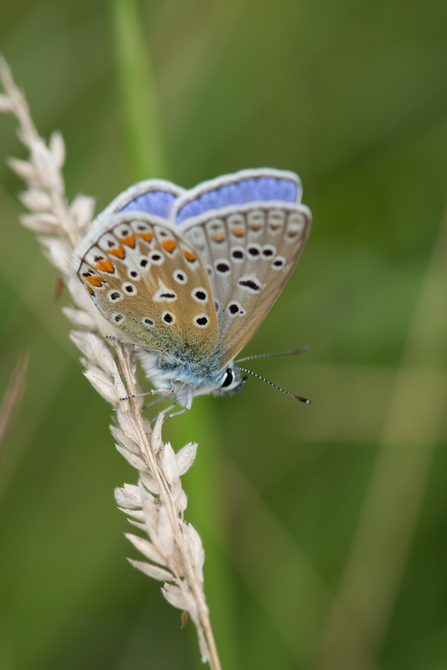
Common Blue at Whitacre Heath
Activity: Listen for the birds
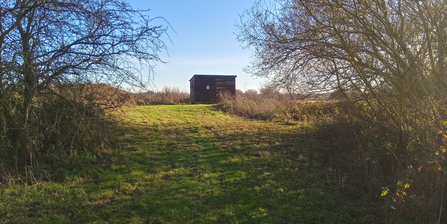
From the hide you have an exceptional view over the southern grasslands “Ross’ Rough” and “The Flash”. These areas are not accessible to the general public in order to reduce disturbance to ground nesting birds. However, you might see cattle grazing here, as they are essential to the success of ground nesting birds and waders as they graze the wet grassland to provide suitable “tussocky” conditions for nesting and feeding. Listen out for the distinctive calls of water rails, snipe and lapwings.
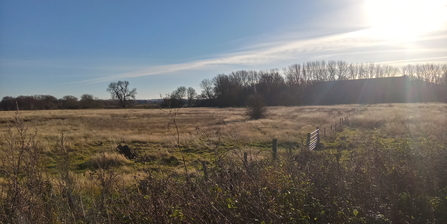
Return when ready
Retrace your steps to return to the wooden gate and then walk along the wide, grassy, raised path to return to the car park
